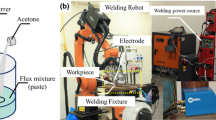Abstract
The distortion and residual stresses arising during the tungsten inert-gas (TIG) welding of the nickel-based superalloy IN718 are modeled using sequentially coupled thermal-mechanical analyses. Processing trials have been carried out for validation purposes, and, for a number of rectilinear testpieces, the distortion has been quantified. The residual stresses in one of the welds have been characterized using the neutron diffraction technique. For the same weld, the thermal cycles induced in the heat-affected zone have been measured; this information, along with the observed shape of the weld pool, enables a suitable description of the weld torch to be made. The modeling is used to rationalize the state of residual stress induced, the distortion that occurs, and its evolution as processing proceeds. It is shown that good predictions can be made of the distortion induced by processing. The residual stresses predicted are reasonable, particularly the longitudinal stresses vary through the thickness, and, since the testpieces are thin, some uncertainties are introduced. Studies are made of the sensitivity of the predictions to the materials data and model formulation.
Similar content being viewed by others
References
Mathematical Modeling of Weld Phenomena, H. Cerjak, ed., The Institute of Materials, London, 1998.
Trends in Welding Research: Proc. 5th Int. Conf., J.M. Vitek and S.A. David, eds., ASM INTERNATIONAL, Materials Park, OH, 1999.
Modeling of Casting, Welding and Advanced Solidification Processes—VIII, B.G. Thomas and C. Beckermann, eds., TMS, Warrendale, PA, 1998.
N.O. Okerblom: The Calculation of Deformation of Welded Metals Structures, HMSO, London, 1958 translated from Russian by L.R. Ronson.
J. Mackerle: Modelling Simulation Mater. Sci. Eng., 1996, vol. 4, pp. 501–33.
J.A. Goldak, M. Bibby, J. Moore, R. House, and B. Patel: Metall. Trans., 1986, vol. 17B, pp. 587–600.
J.A. Goldak, A. Chakrayarti, and M. Bibby: Metall. Trans., 1984, vol. 15B, pp. 299–305.
M.F. Ashby and K.E. Easterling: Acta Metall., 1984, vol. 32, pp. 1935–48.
O. Grong: Metallurgical Modelling of Welding, 2nd ed., Institute of Materials, London, 1997.
L.E. Lindgren and L. Karlsson: Int. J. Num. Methods Eng., 1988, vol. 25, pp. 635–55.
J.B. Leblond: Int. J. Plasticity, 1989, vol. 5, pp. 573–91.
D. Dye, S.M. Roberts, P.J. Wither, and R.C. Reed: J. Strain Analysis, 2000, vol. 35, pp. 247–59.
Y.P. Yang, P. Dong, J. Zhan, and X. Dian: Welding J., 2000, vol. 79, pp. 9s-17s.
J.A. Goldak, M. Gu, and L. Karlsson: in ASM Metals Handbook, ASM INTERNATIONAL, OH, 1993, vol. 6, pp. 1131–40.
J.A. Goldak, A.S. Oddy, J.M.J. McDill, A. Chakavorti, M.J. Bibby, and R. House: in Proc. Int. Conf. on Trends in Welding Research, ASM INTERNATIONAL, OH, 1989, pp. 71–82.
ABAQUS/Standard Users Manual, Hibbitt, Karlsson and Sorenson Inc., Pawtucket, RI, 1999.
J.A. Goldak, V. Breiguine, N. Dai, E. Hughes, and J. Zhou: in Mathematical Modelling of Weld Phenomena 3, H. Cerjak, ed., 543–570, The Institute of Materials, London, 1997, pp. 543–70.
F.W. Brust, P. Dong, and J. Zhang: in Advances in Computational Engineering Science, S.N. Atlur and G. Yagawa, eds., 1997, pp. 51–56.
High Temperature, High Strength Nickel-Base Alloys, Nickel Development Institute, London, 1995.
C.T. Sims, N.S. Stoloff, and W.C. Hagel: Superalloys II, Wiley, New York, NY, 1987.
O. Hunziker, D. Dye, S.M. Roberts, and R.C. Reed: in Mathematical Modelling of Weld Phenomena 5, H. Cerjak and H.K.D.H. Bhadeshia, eds., Institute of Materials, London, July 2001, pp. 299–319.
D. Dye, O. Hunziker, and R.C. Reed: Acta Mater., vol. 49, no. 4, pp. 683–97.
Z. Feng, S.A. David, T. Zacharia, and C.L. Tsai: Sci. Technol. Welding Joining, 1997, vol. 2, pp. 11–19.
Author information
Authors and Affiliations
Rights and permissions
About this article
Cite this article
Dye, D., Hunziker, O., Roberts, S.M. et al. Modeling of the mechanical effects induced by the tungsten inert-gas welding of the IN718 superalloy. Metall Mater Trans A 32, 1713–1725 (2001). https://doi.org/10.1007/s11661-001-0149-z
Received:
Issue Date:
DOI: https://doi.org/10.1007/s11661-001-0149-z




